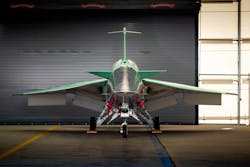NASA's X-59 'Son of Concorde' gearing up for first test flight
PALMDALE, Calif., - Dubbed the "Son of Concorde," NASA's experimental X-59 is almost ready for its first test flights later this year. Formerly called the X-59 Quiet SuperSonic Technology (QueSST) plane, the aircraft could usher in a new era of supersonic mass transportation, Christopher McFadden reports for Interesting Engineering. Continue reading original article.
The Military & Aerospace Electronics take:
10 July 2023 - The National Aeronautics and Space Administration (NASA) released a series of images showing NASA’s X-59 as it sits on the flight line -- the space between the hangar and the runway -- at Lockheed Martin Skunk Works in Palmdale, California, on 19 June 2023. The move from its construction site to the flight line is one of many milestones that prepare the X-59 for its first and subsequent flights. Next up, the team will conduct significant ground tests to ensure the aircraft is safe to fly.
The X-59 aircraft—the centerpiece of NASA’s Quesst mission—is designed to demonstrate the ability to fly supersonic, or faster than Mach 1, while reducing the loud sonic boom to a quiet sonic thump. NASA will then fly the X-59 over several communities to gather data on human responses to the sound generated during supersonic flight. NASA will deliver that data set to U.S. and international regulators to possibly enable commercial supersonic flight over land.
The X-59's engine from General Electric, packs 22,000 pounds of propulsion energy and will power the X-59 as it flies at speeds up to Mach 1.4 and altitudes around 55,000 feet.
The X-59 is designed to fly faster than the speed of sound without producing the typically loud sonic booms that occur when an aircraft flies at supersonic speeds. The advanced X-plane will instead reduce that sound to a quiet sonic “thump”, which will be demonstrated in flights over communities around the U.S. starting in 2024. NASA’s goal is to collect and provide data to regulators that may finally solve the sonic boom challenge and open the future to commercial supersonic flight over land, reducing flight times drastically.
Related: Lockheed's Skunk Works installs GE engine on NASA's X-59 supersonic aircraft
Related: NASA prepares to break the sound barrier with Lockheed Martin's X-59
Related: NASA's X-59 aims to open the skies for new supersonic airliners
Jamie Whitney, Senior Editor
Military + Aerospace Electronics
